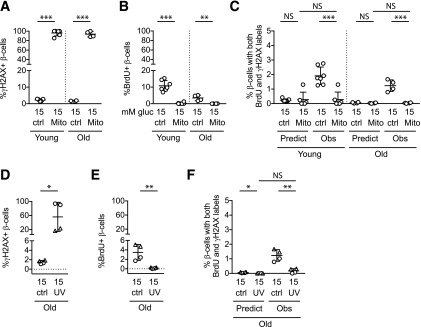Figure 3.
DNA damage does not increase β-cell BrdU incorporation or BrdU-γH2AX colabeling. Dispersed mouse islet cells were cultured for 72 h in the indicated conditions, with BrdU added for the final 24 h. A–C: Mitomycin C treatment resulted in γH2AX labeling in the majority of β-cells, confirming DNA damage. B: Contrary to the hypothesis that BrdU labeling might spuriously occur during DNA damage repair, mitomycin C treatment decreased, rather than increased, the percentage of β-cells labeling for BrdU. C: Double-labeled cells were not increased under conditions of DNA damage; mitomycin C treatment decreased the percentage of β-cells colabeling with both γH2AX and BrdU. In fact, the observed fraction with mitomycin C treatment was suppressed to the fraction predicted if colabeling was due to chance. Mitomycin treatment was performed on the same biological samples and at the same time as the experiments shown in Fig. 2; control data are repeated from Fig. 2. To test the mitomycin result in a different system, UV irradiation treatment (only performed on islets from old mice) increased the percentage of β-cells labeling with γH2AX (D) but suppressed BrdU incorporation (E) and double-labeled cells (F). In D–F, biological replicates with triangle labels and circle labels were treated identically, but in the triangle samples a lower fraction labeled for γH2AX. The different labels are used to allow identification of the samples with lower DNA damage across panels D–G. *P < 0.05, **P < 0.01, ***P < 0.001. ctrl, control; gluc, glucose; Mito, mitomycin; Obs, observed.

